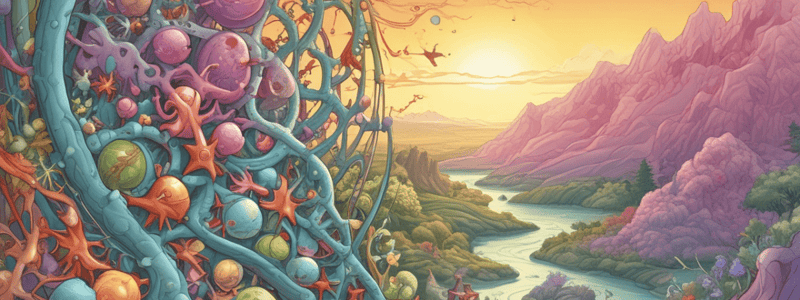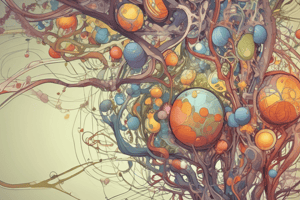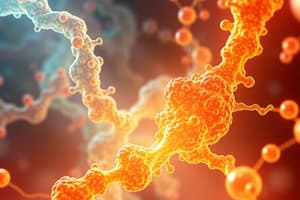Podcast
Questions and Answers
What is the primary difference between anabolic and catabolic reactions in terms of free energy?
What is the primary difference between anabolic and catabolic reactions in terms of free energy?
- Anabolic reactions have a negative ∆G, while catabolic reactions have a positive ∆G
- Anabolic reactions increase entropy, while catabolic reactions decrease entropy
- Anabolic reactions release energy, while catabolic reactions store energy
- Anabolic reactions require energy, while catabolic reactions release energy (correct)
What is the role of enzymes in cellular reactions?
What is the role of enzymes in cellular reactions?
- To increase the activation energy of a reaction
- To reduce the activation energy of a reaction (correct)
- To reduce the entropy of a reaction
- To synthesize new molecules
What is the relationship between entropy and spontaneity in a reaction?
What is the relationship between entropy and spontaneity in a reaction?
- As entropy decreases, spontaneity increases
- There is no correlation between entropy and spontaneity
- As entropy increases, spontaneity decreases
- As entropy increases, spontaneity increases (correct)
What is the significance of the active site in an enzyme-substrate complex?
What is the significance of the active site in an enzyme-substrate complex?
What is the difference between enthalpy and free energy?
What is the difference between enthalpy and free energy?
What is the significance of the ∆G value in a reaction?
What is the significance of the ∆G value in a reaction?
What is the major function of topoisomerase in DNA replication?
What is the major function of topoisomerase in DNA replication?
What is the role of primase in DNA replication?
What is the role of primase in DNA replication?
What is the characteristic of the lagging strand during DNA replication?
What is the characteristic of the lagging strand during DNA replication?
What is the function of helicase in DNA replication?
What is the function of helicase in DNA replication?
What is the result of blocking the transfer of electrons at the CoQ-cytochrome c reductase complex of the mitochondrial ETC?
What is the result of blocking the transfer of electrons at the CoQ-cytochrome c reductase complex of the mitochondrial ETC?
What is the base-pairing rule in the Watson-Crick Model of DNA?
What is the base-pairing rule in the Watson-Crick Model of DNA?
What is the primary function of allosteric effectors in enzymes?
What is the primary function of allosteric effectors in enzymes?
In a negative feedback loop, what is the role of the product of a pathway?
In a negative feedback loop, what is the role of the product of a pathway?
What is the purpose of reaction coupling in metabolic pathways?
What is the purpose of reaction coupling in metabolic pathways?
What is the primary function of topoisomerase during DNA replication?
What is the primary function of topoisomerase during DNA replication?
What is the role of ligase in DNA replication?
What is the role of ligase in DNA replication?
What is the function of NADH in cellular metabolism?
What is the function of NADH in cellular metabolism?
What is the function of the promoter in gene expression?
What is the function of the promoter in gene expression?
What is the role of the electron transport chain in photosynthesis?
What is the role of the electron transport chain in photosynthesis?
What is the net outcome of the light reactions in photosynthesis?
What is the net outcome of the light reactions in photosynthesis?
What is the role of enhancers in gene expression?
What is the role of enhancers in gene expression?
What is the difference between DNA polymerase and RNA polymerase?
What is the difference between DNA polymerase and RNA polymerase?
What is the function of splicing in mRNA processing?
What is the function of splicing in mRNA processing?
What is the primary function of the enzyme Rubisco in the Calvin Cycle?
What is the primary function of the enzyme Rubisco in the Calvin Cycle?
What is the byproduct of the electron transport chain in oxidative phosphorylation?
What is the byproduct of the electron transport chain in oxidative phosphorylation?
During cellular respiration, what happens to the pyruvate molecules produced in glycolysis?
During cellular respiration, what happens to the pyruvate molecules produced in glycolysis?
What is the purpose of fermentation in cellular respiration?
What is the purpose of fermentation in cellular respiration?
What is the role of the mitochondrial inner membrane in oxidative phosphorylation?
What is the role of the mitochondrial inner membrane in oxidative phosphorylation?
What is the product of the light reactions in photosynthesis?
What is the product of the light reactions in photosynthesis?
What is the role of the small ribosomal subunit in translation initiation?
What is the role of the small ribosomal subunit in translation initiation?
What is the function of the P-site in translation?
What is the function of the P-site in translation?
What happens to the tRNA after it delivers its amino acid in translation?
What happens to the tRNA after it delivers its amino acid in translation?
What determines the correct reading frame in translation?
What determines the correct reading frame in translation?
What is the function of ribosomal enzymes in translation?
What is the function of ribosomal enzymes in translation?
What happens when a stop codon lines up with the A-site during translation?
What happens when a stop codon lines up with the A-site during translation?
What is the role of the large ribosomal subunit in translation?
What is the role of the large ribosomal subunit in translation?
What is the purpose of the E-site in translation?
What is the purpose of the E-site in translation?
What determines the direction of transcription given a DNA sequence with the +1 site indicated?
What determines the direction of transcription given a DNA sequence with the +1 site indicated?
What is the function of a release factor during translation?
What is the function of a release factor during translation?
Flashcards are hidden until you start studying
Study Notes
Metabolism
- Metabolism is the sum of all anabolic and catabolic reactions in a cell, connected in a network of reaction pathways
- Anabolic reactions synthesize or "build" molecules with more bonds, using energy and reducing entropy (endergonic and non-spontaneous)
- Catabolic reactions degrade or "break" molecules to make lower free energy products with fewer bonds, releasing energy and increasing entropy (exergonic and spontaneous)
Thermodynamics
- The First and Second Laws of Thermodynamics state that energy is transformed in many ways, but always at the cost of energy lost through entropy that is not available to do work
- Free energy (G) is chemical energy available to do work and is expressed as the difference between enthalpy (total energy) and entropy
- Any reaction involves a change in free energy, ∆G, between reactants and products
- The direction of change in free energy tells if it is positive or negative ∆G (anabolic or catabolic)
Enzymes
- Enzymes are proteins that reduce the activation energy of a reaction
- Enzyme specificity and function are the result of the structure (shape) of the protein
- Substrates interact with enzymes at the active site, forming an enzyme-substrate complex with a close interaction through induced fit
Cellular Respiration
- Cellular respiration is the process of breaking down glucose to make ATP using substrate level and oxidative phosphorylation
- Glycolysis: uses glucose as its preferred substrate to make 2 ATP (Net, via substrate level phosphorylation), 2 NADH, and 2 pyruvate
- Pyruvate oxidation: converts 2 pyruvates into 2 acetyl-CoA, making 2 NADH and 2 CO2
- Citric acid cycle: oxidizes acetyl-CoA to CO2, making 2 ATP (via substrate level phosphorylation), 6 NADH, and 2 FADH2
- Oxidative phosphorylation: uses the energy from NADH and FADH2 to pump H+ into the intermembrane space, generating proton motive force (PMF) across the inner membrane
DNA Structure and Replication
- DNA is a polymer of the four nucleotides A, C, G, and T with the sugar deoxyribose
- Nucleotides can be either purines (A and G) or pyrimidines (C, T, and U)
- The Watson-Crick Model of DNA has four main features:
- Double helix with sugar-phosphate backbone outside
- Antiparallel strands
- Strict base-pairing of nucleotides (A:T; C:G)
- Two strands held together by hydrogen bonding between bases
- DNA replication involves semi-conservative replication: each parental strand from a double helix is used as a template to make a daughter strand along its entire length
Photosynthesis
- Photosynthesis transforms light energy into chemical energy, synthesizing new carbon backbones from CO2 released when cellular respiration breaks down carbon backbones
- The light reactions use two photosystems to capture light and generate high energy electrons
- Electrons leave the light reactions in NADPH, and new electrons are obtained by the splitting of water through photolysis by PSII
- The flow of H+ from high concentration in the lumen to low concentration in the stroma powers the enzyme complex ATP synthase, resulting in the formation of ATP in the stroma (=photophosphorylation)
Central Dogma
- The Central Dogma states: DNA is used to make RNA is used to make Protein
- The information encoding proteins is organized as genes on DNA, and all genes have the same basic structure:
- A transcription start site denoted as "+1" corresponding to the first nucleotide at the 5' end of the RNA product
- A transcribed region that acts as the template for the transcribed RNA, located "downstream" of the transcription start site (base positions denoted by positive numbers)
- A regulatory domain called a promoter located "upstream" of the transcription start site (base positions denoted by negative numbers)
Translation
- Translation occurs in the ribosome, a large multi-protein complex that interacts with mRNA and enzymatically assembles polypeptides
- Initiation of translation occurs when the small ribosomal subunit binds to mRNA near the 5'-end
- During elongation, a charged tRNA enters the A-site, and the ribosomal enzymes cut the growing polypeptide free from the P-site tRNA, and attach it to the new amino acid on the tRNA in the A-site with a peptide bond
- The process repeats until a stop codon lines up with the A-site and binds to a release factor, halting translation
Studying That Suits You
Use AI to generate personalized quizzes and flashcards to suit your learning preferences.




